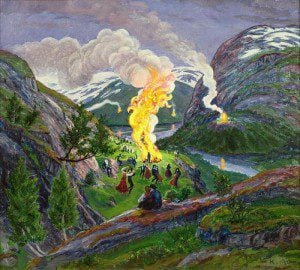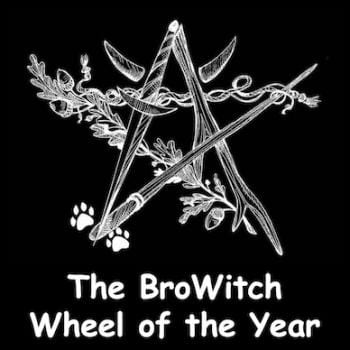 Oh Summer Solstice! I love you as Midsummer! I also sometimes call you Litha, and can sort of appreciate you as the Feast of St. John the Baptist, but why do you have so many names? And the middle of Summer is early August, not June! You aren’t quite a vexing holiday, but I can see why you might be confusing to some people.
Oh Summer Solstice! I love you as Midsummer! I also sometimes call you Litha, and can sort of appreciate you as the Feast of St. John the Baptist, but why do you have so many names? And the middle of Summer is early August, not June! You aren’t quite a vexing holiday, but I can see why you might be confusing to some people.
The other day one of my friends asked “Why is Midsummer called Midsummer?” I had an answer all lined up for her, but it was my wife’s birthday, and the World Cup was on. I’ve got priorities. Most of us probably acknowledge the Summer Solstice as the first day of Summer, but that’s not always been the case, which is how the first day of Summer came to be known as Midsummer.
A lot of early calendars (such as the Icelandic and Anglo-Saxon) only had two seasons in them-Summer and Winter. When Midsummer (and Midwinter) are looked at from that perspective they live up to their names. If the two seasons of Summer and Winter begin on the equinoxes then the solstices are true midway points.
 There’s also another way to look at Midsummer and that’s by beginning the seasons at the Cross-Quarter holidays. If Imbolc is the start of Spring then Beltane is the start of Summer and Lughnassa is the start of Autumn. That puts the Summer Solstice back in the cross-hairs of being “Midsummer.”
There’s also another way to look at Midsummer and that’s by beginning the seasons at the Cross-Quarter holidays. If Imbolc is the start of Spring then Beltane is the start of Summer and Lughnassa is the start of Autumn. That puts the Summer Solstice back in the cross-hairs of being “Midsummer.”
People have never really let celestial events completely define the seasons to begin with. The agricultural cycle of a particular area determines “Summer” and “Winter” to some extent, as does culture. In some ways “Summer” stars when school lets out and “Fall” begins when kids have to go back. That’s how it worked for me growing up. American Civil Religion has turned the Fourth of July into a Patriotic Midsummer Holiday, and fire in the sky (fireworks) isn’t all that different from fire in the fields.
 Only in the last five or so years have I consistently referred to the Summer Solstice as Midsummer. Before that I used the Modern Pagan alternative title of Litha. The word Litha comes to us from the English historian Bede writing in the early 700’s. In Bede Litha isn’t the name of a particular holiday it’s the name of an Anglo-Saxon month of double-length roughly matching up to the modern months of June and July. According to Bede the word litha means: “gentle or navigable, because in both those months the calm breezes are gentle and they were wont to sail upon the smooth sea.” Because the old Anglo-Saxon calendar was lunar and not solar it was sometimes necessary to extend Litha into a third month, in such cases Litha became Trilithi.
Only in the last five or so years have I consistently referred to the Summer Solstice as Midsummer. Before that I used the Modern Pagan alternative title of Litha. The word Litha comes to us from the English historian Bede writing in the early 700’s. In Bede Litha isn’t the name of a particular holiday it’s the name of an Anglo-Saxon month of double-length roughly matching up to the modern months of June and July. According to Bede the word litha means: “gentle or navigable, because in both those months the calm breezes are gentle and they were wont to sail upon the smooth sea.” Because the old Anglo-Saxon calendar was lunar and not solar it was sometimes necessary to extend Litha into a third month, in such cases Litha became Trilithi.
Why do we use the word Litha in some Modern Pagan traditions? Well some people use it because it simply sounds more Pagan; for those attempting to recreate Anglo-Saxon traditions it’s certainly more Germanic than Midsummer. I’m not exactly sure, but if I had to credit any one particular group for introducing the word Litha into Contemporary Paganism I’d say it’s most likely The New Reformed Orthodox Order of the Golden Dawn (NROOGD) and Aidan Kelly*. Kelly is responsible for (or guilty of) most of the cool Pagan sounding name at the equinoxes and solstices, especially Mabon.
There’s another source for Litha that may have inspired Kelly and others and that’s J.R.R. Tolkien. Yes, that Tolkien, the guy who wrote The Hobbit and The Lord of the Rings. The Hobbits of the Shire celebrated Lithe as their Midsummer holiday. Between Lithe were the two months of Forelithe (June) and Afterlithe (July). Tolkien was inspired by Bede, but I wouldn’t be at all surprised to find a few Pagans out there inspired by Tolkien.
 For a solid millennia (and most likely longer) Christians continued to celebrate the Summer Solstice after converting the majority of the pagans. They did this by moving most Midsummer traditions into the celebration of the Nativity of St. John the Baptist. Popping up as an official feast day on the Christian calendar 500 years after the death of Jesus (and John the Baptist) the holiday has always been a clever ploy to give the pagans something to do around the solstice.
For a solid millennia (and most likely longer) Christians continued to celebrate the Summer Solstice after converting the majority of the pagans. They did this by moving most Midsummer traditions into the celebration of the Nativity of St. John the Baptist. Popping up as an official feast day on the Christian calendar 500 years after the death of Jesus (and John the Baptist) the holiday has always been a clever ploy to give the pagans something to do around the solstice.
St. John’s Feast Day is customarily celebrated on June 24 so it’s a couple days after the solstice (and depending on how messed up a calendar was during any particular era sometimes longer than just a few days), but that’s of little consequence. Most of our holiday traditions over the centuries have been shuffled around a little bit, what’s a few days? Bonfires, sacred smoke, and magical operations became a part of St. John’s Feast, with St. John’s Eve being just as important to many revelers and cunning-folk. St. John’s Feast Day is also regularly called Midsummer and was another holiday the Christians just couldn’t shake the pagan out of.
Whatever you celebrate and however you celebrate it, I hope your Midsummer is great!
*That hunch is backed up in this article, which I found while re-reading John Halstead’s Mabon, Mabon Not.













